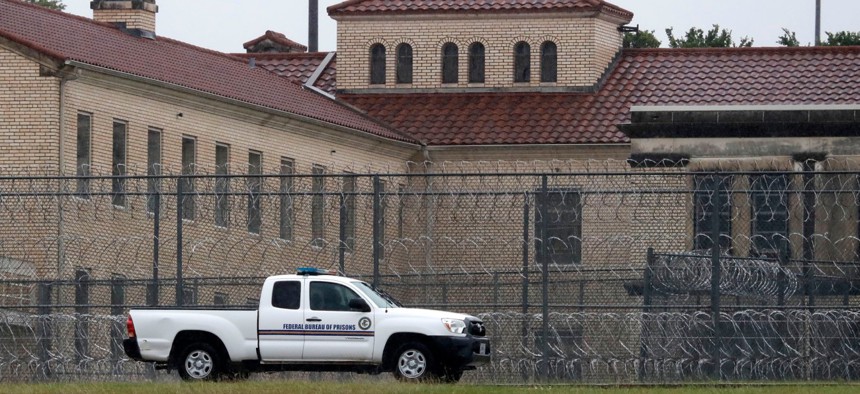
A Federal Bureau of Prisons truck drives past the Federal Medical Center prison in Fort Worth, Texas, in May. The facility had already had hundreds of inmates test positive for COVID-19. LM Otero / AP
Federal Bureau of Prisons Spent $3M on Unproven UV Coronavirus Sanitizing Portals
The gates intended to disinfect staff as they enter facilities haven’t been studied enough to know if they are safe or effective, union says in complaint to IG.
A recent complaint to the Justice Department inspector general criticizes the Federal Bureau of Prisons for spending almost $3 million on ultraviolet technology meant to rid staff of any novel coronavirus germs they may be carrying as they enter facilities. The disinfecting technology is largely unproven and could have harmful side effects on staff members’ health, the complaint says.
Joe Rojas, Southeast regional vice president at the American Federation of Government Employees’ Council of Prison Locals, filed the complaint with the IG on behalf of the union on July 30. BOP awarded a $2,965,373 contract to G.M. Hill Engineering, a Florida-based company, for the ultraviolet sanitizing portals on April 16. All gates have been shipped for an estimated delivery period of June 16 to October 31, 2020, and the agency has started to install them, according to BOP.
A week after the bureau awarded the contract, President Trump during an April 23 press briefing touted the idea of using UV light, along with bleach and isopropyl alcohol, to prevent the virus’s spread. But on April 24, the International Ultraviolet Association issued a warning discouraging the use of UV light to disinfect individuals from the novel coronavirus because while UV light can kill viruses it has also led to skin cancer, eye damage and severe skin burns. This was referenced in the complaint to the IG.
Nonetheless, there has been a debate over businesses, airports and other facilities adopting UV technology to prevent the spread of coronavirus. “UV rays [create] a weakness in that chain [leading to coronavirus infection],” said Homeland Security Department acting Undersecretary for Science and Technology William Bryan, during the April White House briefing.
BOP said it did not test the gates prior to signing the contract, but it did ensure they were approved by the Environmental Protection Agency and UL, a global safety certification company. “BOP has begun to set up and install these UV portals to be used by staff and contractors, on a voluntary basis, when entering our facilities,” BOP spokesman Scott Taylor told Government Executive on Tuesday. “These portals are a supplement to the BOP's overarching efforts to ensure the safety and health of our staff and inmates during the pandemic.”
While some studies have shown UV can be used against the coronavirus, “the problem is that there’s no research to show what the long-term effect of these wavelengths is on humans,” said Jim Bolton, international expert on the application of UV light. “In my view it’s not advisable to go ahead with the application...until the research is done.”
Similarly, the International Ultraviolet Association gave the following statement to Government Executive:
"Based on currently available contract information, the International Ultraviolet Association understands the BOP has procured far UV-C devices (i.e., UV sanitary entry gates) that would be used to directly expose people to UV light, which IUVA cautioned against in April 2020. Further, per its July 2020 position paper, IUVA holds that there is not yet sufficient evidence to support widespread application of far UV-C where direct human exposure is anticipated, and that far UV-C not be implemented as an unshielded disinfection technology until sufficient evidence for safety is presented, and suitable protocols for application are established.”
The National Academies of Sciences, Engineering and Medicine also said more research is needed on using UV light to curb the spread of coronavirus.
BOP has been struggling with a coronavirus outbreak among staff and inmates. As of Thursday afternoon, there were 1,544 open cases among federal inmates and 548 among staff. So far, 9,249 inmates and 756 staff have recovered. But some staff expressed concern the portals are not the best way to address the outbreak.
“It’s inexplicable to spend almost $3 million on unproven technologies,” said Rojas. “That money could have gone to bring staff or [purchase personal protective equipment].” He also noted that some of the agency’s 122 locations that are suffering “are at critical levels when it comes to staffing,” which has been a long-term issue.
“Staff are afraid of getting cancer and the fact that they put these inside every institution is scary,” Aaron McGlothin, a California correctional officer and local union president, told Government Executive. “They did not do their proper research. It all leads to just knee-jerk reactions and the employees are the ones who suffer.”
This was the only pandemic-related contract G.M. Hill Engineering received, according to ProPublica’s coronavirus contract tracker, but the company has received contracts from various federal agencies for other matters, as shown in FedBizOpps, the federal procurement website.
The company did not respond to a request for comment.







